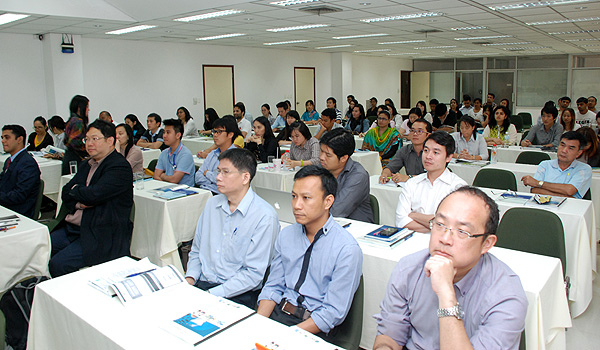Organized by the Regional Network Office for Urban Safety (RNUS),
School of Engineering and Technology, AIT; and the International Center
for Urban Safety Engineering (ICUS), The University of Tokyo in
cooperation with Esri (Thailand) Co., Ltd, the seminar on 10 February
2014 attracted a large on-campus audience of faculty, staff and
students.
AIT Interim President Prof. Worsak
Kanok-Nukulchai welcomed the delegates to the “Seminar 2014: GIS for
Environmental Management in Asia”. He expressed his gratitude to Esri
for the firm’s long-term support for GIS education and research at the
Institute, in particular a new donation of books.
In his keynote address titled “Spacial
thinking and problem-solving with GIS,” Dr. Michael Gould, Global
Education Manager, Esri, USA, pointed out that the technology is no
longer only for geographers, as it has tremendous applications for
business and society, including the environment.
“GIS is a problem-solving technology for
everyone,” he told the seminar. “Whether it is used for business,
astronomy, engineering, the environment or any other application, we
use GIS to solve problems across space.”
Indeed, logisticians can assess real-time
movements along transportation corridors, telecom operators can know
where best to locate a mobile phone tower, urban planners can evaluate
the optimal site for a hospital, and marketers can study populations’
purchasing power, he said, as examples.
University administrators and planners
would do well to avail of existing templates to create dreamed of
“smart campuses”, he recommended. In a nod to the future, Dr. Gould
predicted that “mobility” will be the driving force for research and
applications.
Speaking to AIT engineering students, the
Esri senior executive said his firm – which is the world’s largest
international supplier of Geographic Information Systems software, web
GIS and geo-database management applications – needs many skilled
people to construct the “new GIS.”
Public health, disaster management and
humanitarian work are all sectors that could benefit from well-trained
personnel and advances in GIS. Employers don’t advertise positions as
‘GIS person’, but value technicians who can think spacially across all
disciples, he added.
Overall, the continent faces a wide-range
of complex challenges and opportunities for good governance, economic
cooperation, trans-border resource management, disaster mitigation and
infectious disease prevention. GIS allows the rapid arrangement of
geospatial data infrastructure for comprehensive analyses of multiple
data at local levels.
Delivering a keynote lecture titled
“Geospacial Analysis for disease surveillance and hotspots” AIT’s Prof.
Nitin Kumar Tripathi outlined how AIT researchers were able to identify
the annual dengue diffusion in Chachoengsao province, Thailand, through
epidemic mapping models.
AIT postgraduate students and junior
researchers contributed with presentations “Biofuel crop substitution
modeling”, “Cooperative game analysis of transboundary hydropower
development in the Lower Mekong”, “Urban fire risk mapping”, and
“Assessment of hydropower potential and hydrological modeling under
current and future climate in Dudh Koshi Basin, Nepal”.
Dr. Sukit Visehsin, Spacial Products
Department Manager, Esri (Thailand), highlighted the status of
Thailand’s GIS, saying the country crucially needs a “national portal”
that would enable the development and sharing of Web applications by
“anyone, anywhere, anytime.”
The entry level for accessing data is now the cloud, he explained, so
GIS is no longer confined to desktops and servers. “Today’s GIS is
really about everything, everywhere for everyone," he said
Dr. Akiyuki Kawasaki, Visiting Faculty, AIT and Project Associate
Prof. of ICUS, IIS, University of Tokyo was the lead organizer and
emcee of the seminar.
READ: For more information on
Esri


